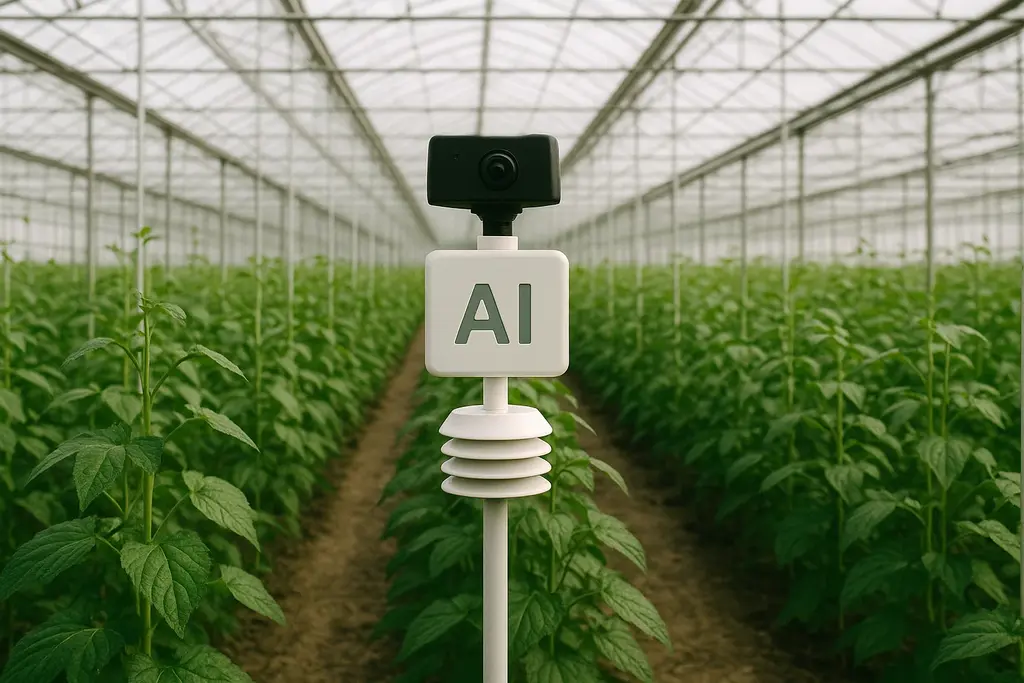In a time when growers face mounting challenges — from rising energy prices to an increasing shortage of skilled labour — one company is quietly building a case for smarter, more responsive agriculture. Gardin, a UK-based agrotech firm, has developed a sensor system that monitors crop photosynthesis in real time, allowing farmers to understand their plants’ health before visible signs of stress appear. By combining advanced optics with artificial intelligence, this tool is designed to guide precise, timely interventions in greenhouses and controlled farming environments.
Since its commercial launch in June 2023, Gardin’s technology has found applications across a wide variety of climates and conditions — from the sun-baked polytunnels of Spain and Morocco to the climate-controlled greenhouses of the Netherlands and Canada. The sensors are currently being used to monitor over 20 different types of crops, ranging from algae to tomatoes. Farmers using the system have reported significant benefits, with some claiming up to a tenfold return on their investment.
At the heart of Gardin’s offering is an optical photosynthesis sensor that captures changes in plant activity with remarkable sensitivity. These changes are interpreted by Gardin’s AI to generate actionable insights — data that helps growers tweak their approach based on what the plants actually need, whether that’s more or less light, water, or energy.
Responding to a Growing Demand for Smarter Tools in a Changing Industry
The timing of Gardin’s rise is notable. The global market for Controlled Environment Agriculture (CEA), estimated at $200 billion, is expanding quickly. But despite this growth, the sector is grappling with serious stressors: soaring energy bills, a tightening pool of skilled workers, and increasing regulatory scrutiny around emissions. Adding to the complexity, traditional farming systems often fall short in processing data fast enough to keep up with real-time crop conditions. This mismatch leads to delays, inefficiencies, and ultimately, lost yields.
In this context, Gardin’s platform is being welcomed not only for its scientific value but also for its practicality. Growers are under pressure to do more with less, and Gardin’s system helps them make decisions that are more informed and timely — a shift that is becoming increasingly essential in today’s climate.
By 2025, the company plans to deepen its focus on helping growers optimise light usage and improve energy efficiency. Early results from trials suggest that users could reduce energy consumption by 20 to 30 percent — a substantial figure at a time when electricity and fuel are among the biggest costs in greenhouse farming.
Beyond the day-to-day management of farms, the data collected through Gardin’s sensors is also proving useful in agricultural research. By providing consistent feedback on how plants respond to different inputs and environments, the system helps breeders identify more resilient seed varieties — a contribution that could support long-term goals around food security and sustainability.
Also read: Biotechnology in Indian Agriculture: Unlocking Potential Amidst Reluctance
Growers Share Early Results and Insights from the Field
For many farmers, the appeal of Gardin’s system lies in its ability to transform subjective guesswork into evidence-based action.
Sander Baraké, CTO at Ridder, underlined the impact of the technology in moving away from conventional environmental management towards a more responsive, crop-focused strategy. “For many years now we have been able to effectively automate climate control around the crop, the next phase is to incorporate real time feedback from the crop and move from ‘climate control’ towards ‘crop control’. Gardin has developed the key technology to enable this. Results include profitability boosts of up to 30% by optimizing winter LED efficiency and maximising summer light. Yield increases of up to 15% and early detection of biotic and abiotic stresses by up to 4 weeks before crop walking.” he said.
“The sensor contributes to homogeneous production with high quality and cost control. Overall, I estimate yield is at least 5% higher per square meter,” said Leonard Boer, Owner & Head Grower, Fromboer
Fuelled by Investor Confidence and Strategic Partnerships
Backed by industry investors like Navus Ventures, Gardin is entering a new phase of growth. The company is now working to strengthen its commercial team and expand its customer base beyond current geographies. Job openings for roles supporting this expansion are currently live on their platform.
Sumanta Talukdar, Gardin’s founder and CEO, brings previous experience in optics and sensor technology, having co-founded and successfully exited WaveOptics in a deal exceeding $500 million. Reflecting on the partnership with Navus, Talukdar said,
For Navus Ventures, the alignment with Gardin was also clear. “Gardin has developed a unique affordable technology that gives growers an actual pulse on their plants and therefore business,” said Jaap Zijlstra, Director at Navus. “A great addition to our portfolio and fit with our strategy and background, we are looking forward to helping Sumanta and the Gardin team through the next phase of commercial scaling.”
While Gardin’s technology is clearly gaining attention, its success may ultimately hinge on how well it continues to integrate into the day-to-day workflows of growers. In an industry that values precision but also depends on intuition and experience, tools like Gardin’s will need to complement human judgement rather than replace it.
As pressures in the controlled agriculture industry mount, the need for better-informed decision-making becomes more urgent. Gardin’s system isn’t a silver bullet, but for a growing number of farmers, it offers a clearer window into what their crops are experiencing — and what they need to thrive.


